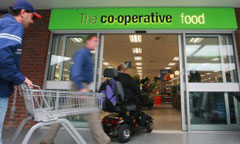 The Sun’s excellent City page, otherwise known as the “page you can trust”, unveiled the High Noon headline last week after some stinking results posted by the Co-op. It quoted Peter Marks, its chief executive, as having said that people were cutting back on food for the first time in his working life.
The Sun’s excellent City page, otherwise known as the “page you can trust”, unveiled the High Noon headline last week after some stinking results posted by the Co-op. It quoted Peter Marks, its chief executive, as having said that people were cutting back on food for the first time in his working life.
“Co-op profits dive triggers panic,” suggested the Sun. But so too did the resignation of Steve Jobs, Heineken’s announcement of sales falls in the first half of its current financial year, and any number of other corporate events. In a sense the Co-op’s pain should be welcome as it confirms the story that the Kantar Worldpanel sales estimates have been telling us every month – the Co-op is losing market share. Local shopkeepers collectively are doing better than the Co-op, which means its 3.6 per cent like-for-like fall in sales (at a time when grocery inflation is nearly 5 per cent) should be your bottom end benchmark.
Our village is served by a Co-op that was previously a Somerfield. It is a good shop with a decent range of food. It is well presented. Its staff are polite. Up front it has good promotions. Most independent shops would be pleased to match its standards. Which I guess is where the panic may kick in for an independent convenience store owner. Being OK is no longer good enough to ensure that your business will be successful.
The Co-op is not standing still. It talks a good story. Its management claims that after two years when integrating Somerfield was the top priority, it is now able to spend time focused on new product development. It says the recent relaunch of its Truly Irresistible range has been a big success, with sales up 30 per cent year on year. It aims to follow this by launching Eat-in and Free-from ranges, a new wholefoods range, and to significantly increase the presence in store of “own grown British products”.
“Work is underway to enhance the range, segment the customer offer and overhaul the ways in which products and produce are replenished in-store,” the Co-op says. In its TV advertisements it says that it is good with food, which leads to the question of what it is for.
Ed Garner of Kantar Worldpanel reckons the Co-op strategy is to retain the same number of shoppers but to increase the amount that they spend with them. Unlike Waitrose, which aims to get more shoppers spending the same as its existing customers. Clearly the Waitrose strategy is working and the Co-op’s is not.
In much of Mr Garner’s analysis, the Co-op appears to be coming third to Waitrose and Sainsbury in terms of the up-market customer offer – high on organic, locally sourced and so on. While there are many independents who aspire to work in this segment of the market, most are slightly less ambitious, relying to a greater extent on alcohol and CTN sales.
Looked at this way, the Co-op’s results may suggest that you do not need to panic so much as be careful about positioning your store so it appeals to the same shoppers that Waitrose and Sainsbury, to a lesser extent, already own.





Comments
This article doesn't have any comments yet, be the first!